Leadership, Training, and Talent Management in the NHS: A Report
VerifiedAdded on 2020/10/23
|10
|2572
|167
Report
AI Summary
This report provides an in-depth analysis of people management within the National Health Service (NHS). It begins by exploring key theoretical models across three critical areas: leadership and management, training and development, and talent management, contextualizing them within the current NHS scenario. The report then delves into the roles and priorities of NHS management and the human resources function in supporting effective management, including the application of leadership styles like autocratic and democratic approaches, the use of Theory X and Theory Y for employee motivation, and the implementation of the AARRR model for talent management. It also examines the internal and external influences impacting these areas. The report concludes with recommendations for enhancing leadership, training, and talent management practices within the NHS, including strategies for performance assessment, performance review, and aligning objectives to improve the overall effectiveness of the healthcare system. The report emphasizes the importance of human resource management in driving performance and achieving the NHS's goals.

Introduction to People and
Management
Management
Paraphrase This Document
Need a fresh take? Get an instant paraphrase of this document with our AI Paraphraser
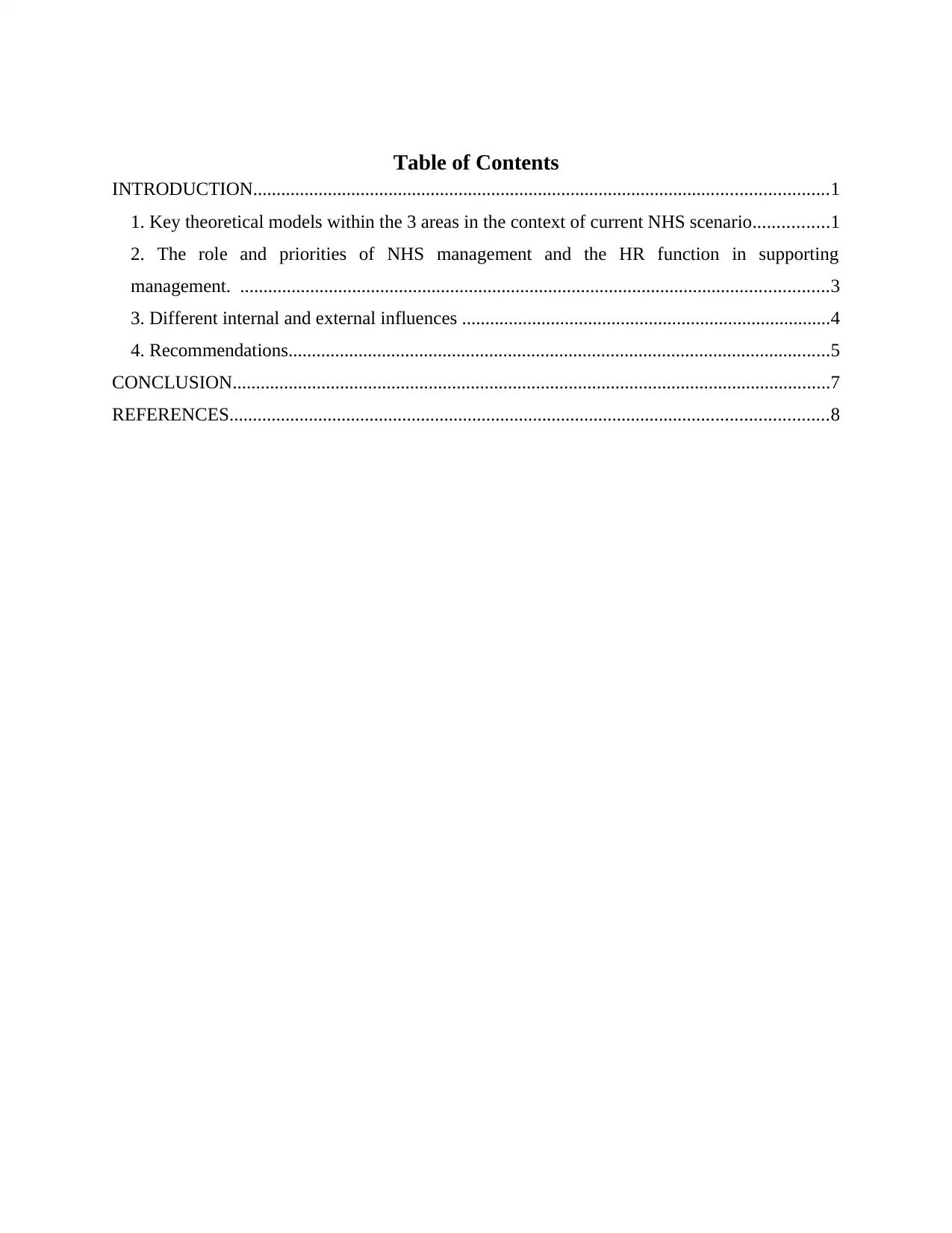
Table of Contents
INTRODUCTION...........................................................................................................................1
1. Key theoretical models within the 3 areas in the context of current NHS scenario................1
2. The role and priorities of NHS management and the HR function in supporting
management. ..............................................................................................................................3
3. Different internal and external influences ...............................................................................4
4. Recommendations....................................................................................................................5
CONCLUSION................................................................................................................................7
REFERENCES................................................................................................................................8
INTRODUCTION...........................................................................................................................1
1. Key theoretical models within the 3 areas in the context of current NHS scenario................1
2. The role and priorities of NHS management and the HR function in supporting
management. ..............................................................................................................................3
3. Different internal and external influences ...............................................................................4
4. Recommendations....................................................................................................................5
CONCLUSION................................................................................................................................7
REFERENCES................................................................................................................................8
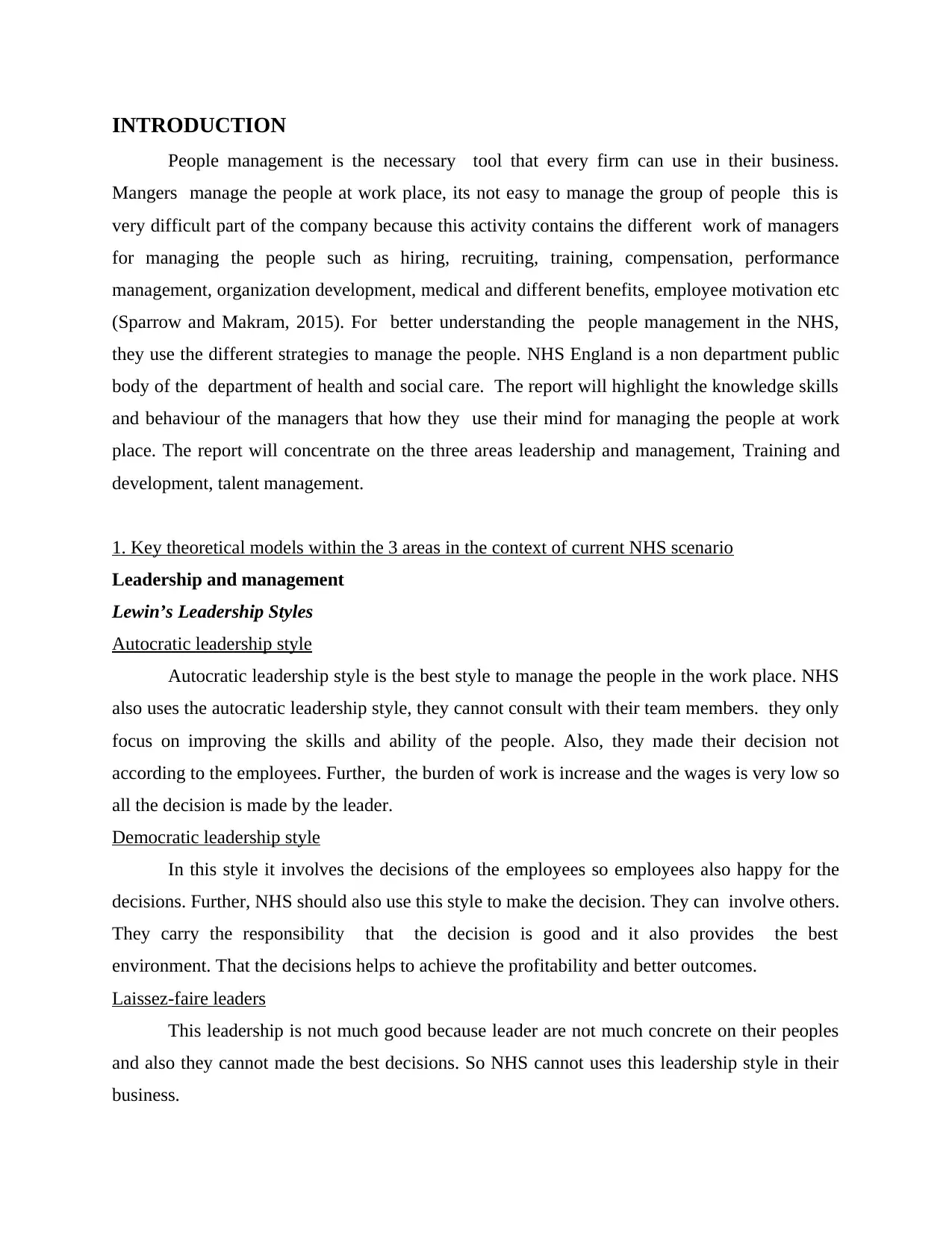
INTRODUCTION
People management is the necessary tool that every firm can use in their business.
Mangers manage the people at work place, its not easy to manage the group of people this is
very difficult part of the company because this activity contains the different work of managers
for managing the people such as hiring, recruiting, training, compensation, performance
management, organization development, medical and different benefits, employee motivation etc
(Sparrow and Makram, 2015). For better understanding the people management in the NHS,
they use the different strategies to manage the people. NHS England is a non department public
body of the department of health and social care. The report will highlight the knowledge skills
and behaviour of the managers that how they use their mind for managing the people at work
place. The report will concentrate on the three areas leadership and management, Training and
development, talent management.
1. Key theoretical models within the 3 areas in the context of current NHS scenario
Leadership and management
Lewin’s Leadership Styles
Autocratic leadership style
Autocratic leadership style is the best style to manage the people in the work place. NHS
also uses the autocratic leadership style, they cannot consult with their team members. they only
focus on improving the skills and ability of the people. Also, they made their decision not
according to the employees. Further, the burden of work is increase and the wages is very low so
all the decision is made by the leader.
Democratic leadership style
In this style it involves the decisions of the employees so employees also happy for the
decisions. Further, NHS should also use this style to make the decision. They can involve others.
They carry the responsibility that the decision is good and it also provides the best
environment. That the decisions helps to achieve the profitability and better outcomes.
Laissez-faire leaders
This leadership is not much good because leader are not much concrete on their peoples
and also they cannot made the best decisions. So NHS cannot uses this leadership style in their
business.
People management is the necessary tool that every firm can use in their business.
Mangers manage the people at work place, its not easy to manage the group of people this is
very difficult part of the company because this activity contains the different work of managers
for managing the people such as hiring, recruiting, training, compensation, performance
management, organization development, medical and different benefits, employee motivation etc
(Sparrow and Makram, 2015). For better understanding the people management in the NHS,
they use the different strategies to manage the people. NHS England is a non department public
body of the department of health and social care. The report will highlight the knowledge skills
and behaviour of the managers that how they use their mind for managing the people at work
place. The report will concentrate on the three areas leadership and management, Training and
development, talent management.
1. Key theoretical models within the 3 areas in the context of current NHS scenario
Leadership and management
Lewin’s Leadership Styles
Autocratic leadership style
Autocratic leadership style is the best style to manage the people in the work place. NHS
also uses the autocratic leadership style, they cannot consult with their team members. they only
focus on improving the skills and ability of the people. Also, they made their decision not
according to the employees. Further, the burden of work is increase and the wages is very low so
all the decision is made by the leader.
Democratic leadership style
In this style it involves the decisions of the employees so employees also happy for the
decisions. Further, NHS should also use this style to make the decision. They can involve others.
They carry the responsibility that the decision is good and it also provides the best
environment. That the decisions helps to achieve the profitability and better outcomes.
Laissez-faire leaders
This leadership is not much good because leader are not much concrete on their peoples
and also they cannot made the best decisions. So NHS cannot uses this leadership style in their
business.
⊘ This is a preview!⊘
Do you want full access?
Subscribe today to unlock all pages.

Trusted by 1+ million students worldwide
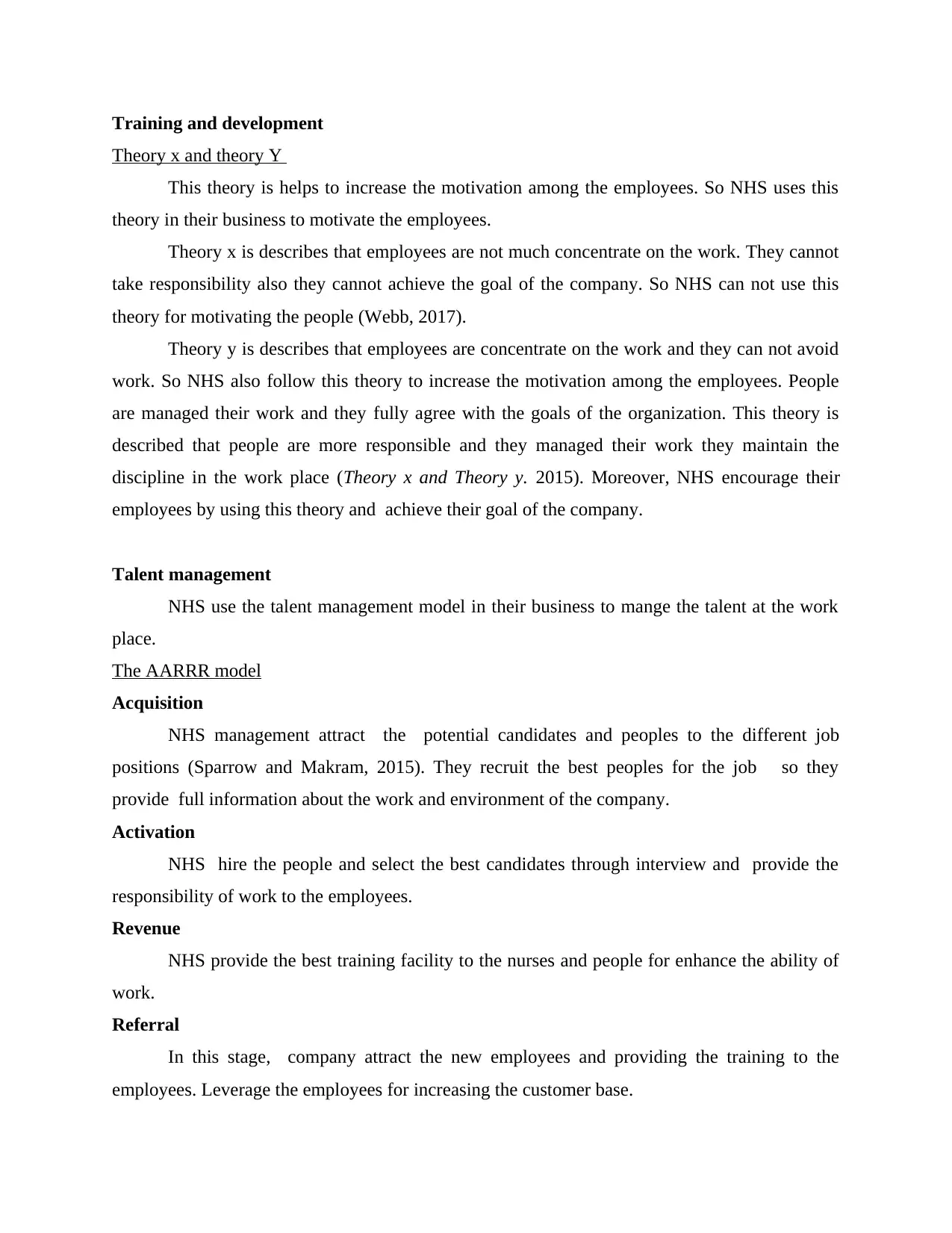
Training and development
Theory x and theory Y
This theory is helps to increase the motivation among the employees. So NHS uses this
theory in their business to motivate the employees.
Theory x is describes that employees are not much concentrate on the work. They cannot
take responsibility also they cannot achieve the goal of the company. So NHS can not use this
theory for motivating the people (Webb, 2017).
Theory y is describes that employees are concentrate on the work and they can not avoid
work. So NHS also follow this theory to increase the motivation among the employees. People
are managed their work and they fully agree with the goals of the organization. This theory is
described that people are more responsible and they managed their work they maintain the
discipline in the work place (Theory x and Theory y. 2015). Moreover, NHS encourage their
employees by using this theory and achieve their goal of the company.
Talent management
NHS use the talent management model in their business to mange the talent at the work
place.
The AARRR model
Acquisition
NHS management attract the potential candidates and peoples to the different job
positions (Sparrow and Makram, 2015). They recruit the best peoples for the job so they
provide full information about the work and environment of the company.
Activation
NHS hire the people and select the best candidates through interview and provide the
responsibility of work to the employees.
Revenue
NHS provide the best training facility to the nurses and people for enhance the ability of
work.
Referral
In this stage, company attract the new employees and providing the training to the
employees. Leverage the employees for increasing the customer base.
Theory x and theory Y
This theory is helps to increase the motivation among the employees. So NHS uses this
theory in their business to motivate the employees.
Theory x is describes that employees are not much concentrate on the work. They cannot
take responsibility also they cannot achieve the goal of the company. So NHS can not use this
theory for motivating the people (Webb, 2017).
Theory y is describes that employees are concentrate on the work and they can not avoid
work. So NHS also follow this theory to increase the motivation among the employees. People
are managed their work and they fully agree with the goals of the organization. This theory is
described that people are more responsible and they managed their work they maintain the
discipline in the work place (Theory x and Theory y. 2015). Moreover, NHS encourage their
employees by using this theory and achieve their goal of the company.
Talent management
NHS use the talent management model in their business to mange the talent at the work
place.
The AARRR model
Acquisition
NHS management attract the potential candidates and peoples to the different job
positions (Sparrow and Makram, 2015). They recruit the best peoples for the job so they
provide full information about the work and environment of the company.
Activation
NHS hire the people and select the best candidates through interview and provide the
responsibility of work to the employees.
Revenue
NHS provide the best training facility to the nurses and people for enhance the ability of
work.
Referral
In this stage, company attract the new employees and providing the training to the
employees. Leverage the employees for increasing the customer base.
Paraphrase This Document
Need a fresh take? Get an instant paraphrase of this document with our AI Paraphraser
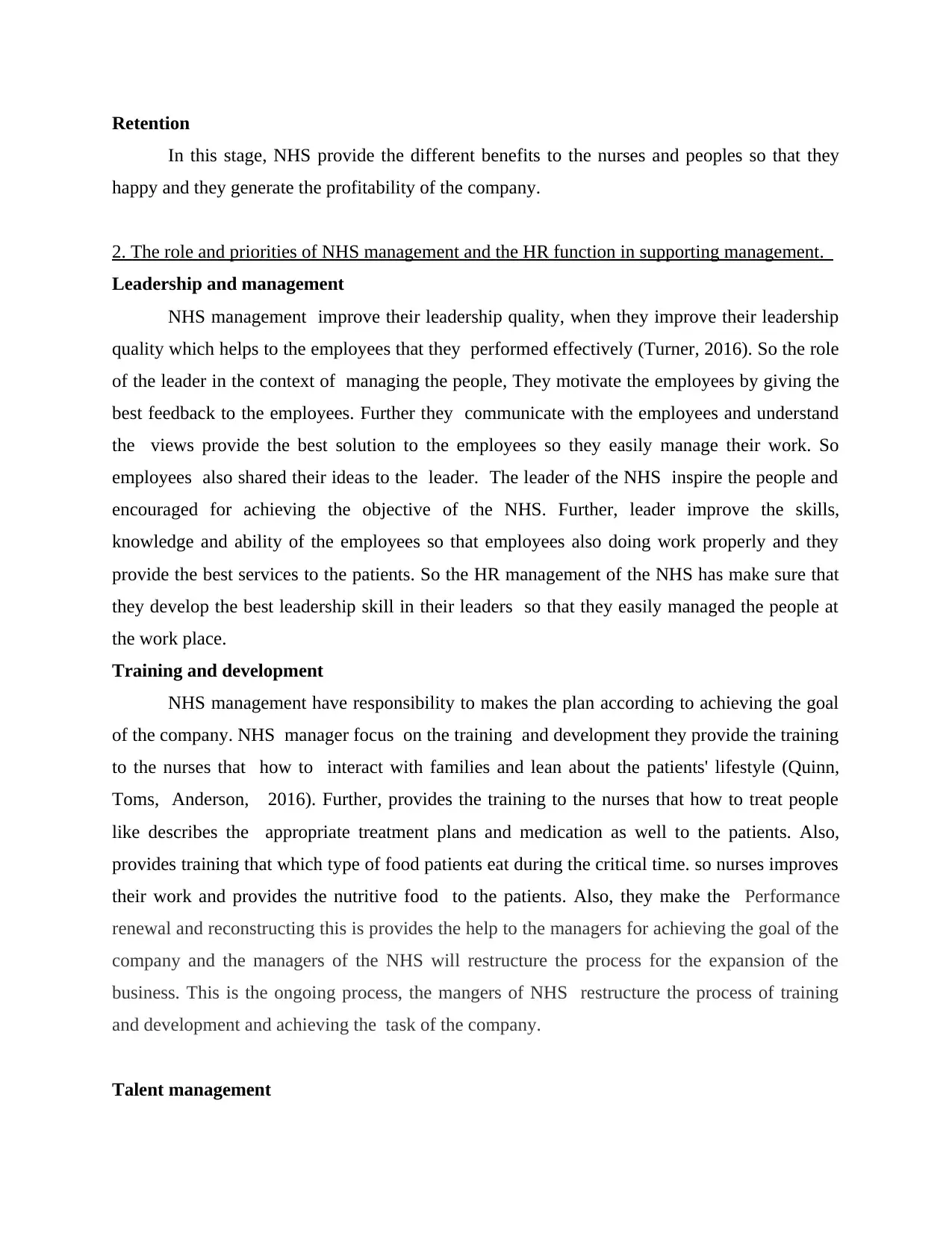
Retention
In this stage, NHS provide the different benefits to the nurses and peoples so that they
happy and they generate the profitability of the company.
2. The role and priorities of NHS management and the HR function in supporting management.
Leadership and management
NHS management improve their leadership quality, when they improve their leadership
quality which helps to the employees that they performed effectively (Turner, 2016). So the role
of the leader in the context of managing the people, They motivate the employees by giving the
best feedback to the employees. Further they communicate with the employees and understand
the views provide the best solution to the employees so they easily manage their work. So
employees also shared their ideas to the leader. The leader of the NHS inspire the people and
encouraged for achieving the objective of the NHS. Further, leader improve the skills,
knowledge and ability of the employees so that employees also doing work properly and they
provide the best services to the patients. So the HR management of the NHS has make sure that
they develop the best leadership skill in their leaders so that they easily managed the people at
the work place.
Training and development
NHS management have responsibility to makes the plan according to achieving the goal
of the company. NHS manager focus on the training and development they provide the training
to the nurses that how to interact with families and lean about the patients' lifestyle (Quinn,
Toms, Anderson, 2016). Further, provides the training to the nurses that how to treat people
like describes the appropriate treatment plans and medication as well to the patients. Also,
provides training that which type of food patients eat during the critical time. so nurses improves
their work and provides the nutritive food to the patients. Also, they make the Performance
renewal and reconstructing this is provides the help to the managers for achieving the goal of the
company and the managers of the NHS will restructure the process for the expansion of the
business. This is the ongoing process, the mangers of NHS restructure the process of training
and development and achieving the task of the company.
Talent management
In this stage, NHS provide the different benefits to the nurses and peoples so that they
happy and they generate the profitability of the company.
2. The role and priorities of NHS management and the HR function in supporting management.
Leadership and management
NHS management improve their leadership quality, when they improve their leadership
quality which helps to the employees that they performed effectively (Turner, 2016). So the role
of the leader in the context of managing the people, They motivate the employees by giving the
best feedback to the employees. Further they communicate with the employees and understand
the views provide the best solution to the employees so they easily manage their work. So
employees also shared their ideas to the leader. The leader of the NHS inspire the people and
encouraged for achieving the objective of the NHS. Further, leader improve the skills,
knowledge and ability of the employees so that employees also doing work properly and they
provide the best services to the patients. So the HR management of the NHS has make sure that
they develop the best leadership skill in their leaders so that they easily managed the people at
the work place.
Training and development
NHS management have responsibility to makes the plan according to achieving the goal
of the company. NHS manager focus on the training and development they provide the training
to the nurses that how to interact with families and lean about the patients' lifestyle (Quinn,
Toms, Anderson, 2016). Further, provides the training to the nurses that how to treat people
like describes the appropriate treatment plans and medication as well to the patients. Also,
provides training that which type of food patients eat during the critical time. so nurses improves
their work and provides the nutritive food to the patients. Also, they make the Performance
renewal and reconstructing this is provides the help to the managers for achieving the goal of the
company and the managers of the NHS will restructure the process for the expansion of the
business. This is the ongoing process, the mangers of NHS restructure the process of training
and development and achieving the task of the company.
Talent management
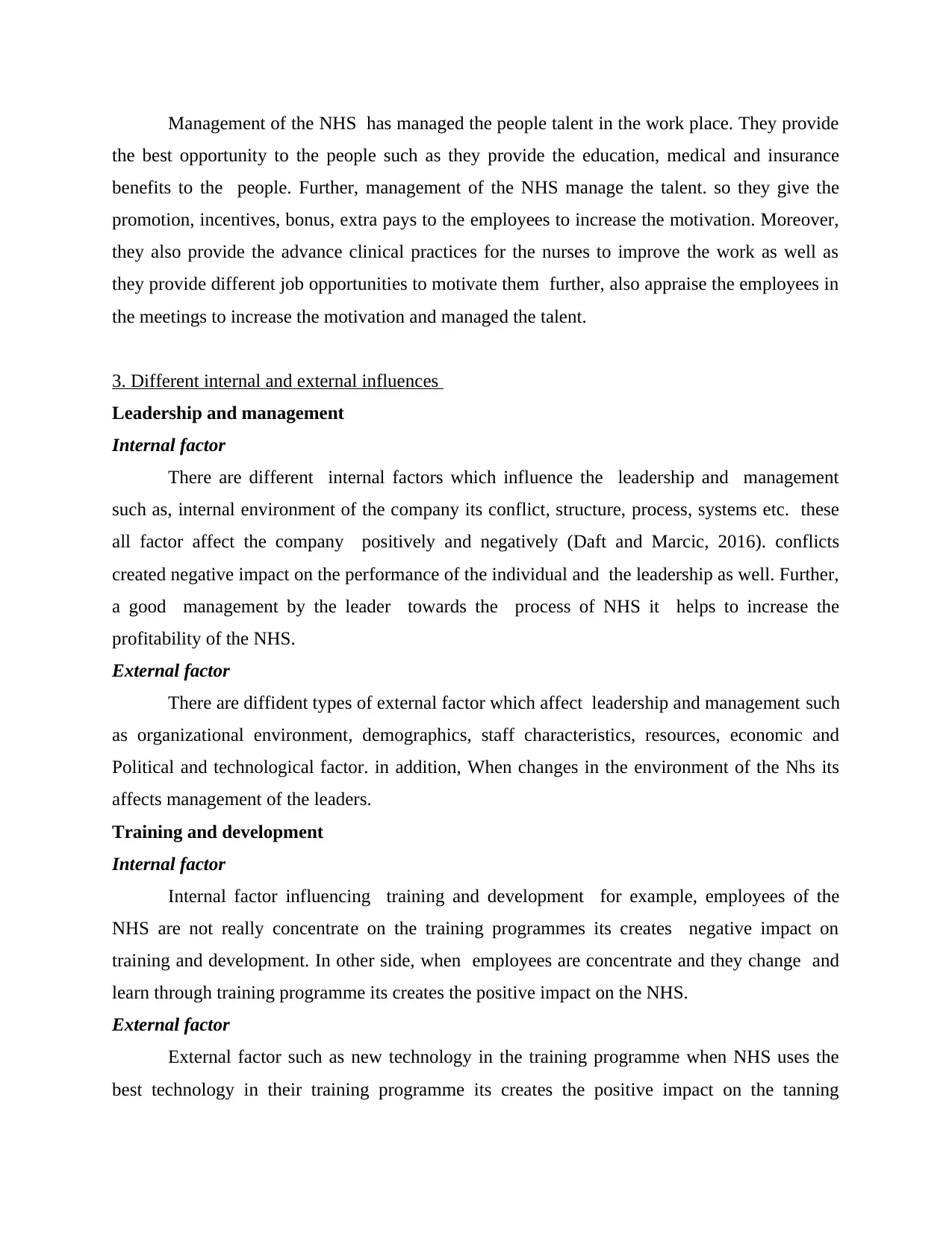
Management of the NHS has managed the people talent in the work place. They provide
the best opportunity to the people such as they provide the education, medical and insurance
benefits to the people. Further, management of the NHS manage the talent. so they give the
promotion, incentives, bonus, extra pays to the employees to increase the motivation. Moreover,
they also provide the advance clinical practices for the nurses to improve the work as well as
they provide different job opportunities to motivate them further, also appraise the employees in
the meetings to increase the motivation and managed the talent.
3. Different internal and external influences
Leadership and management
Internal factor
There are different internal factors which influence the leadership and management
such as, internal environment of the company its conflict, structure, process, systems etc. these
all factor affect the company positively and negatively (Daft and Marcic, 2016). conflicts
created negative impact on the performance of the individual and the leadership as well. Further,
a good management by the leader towards the process of NHS it helps to increase the
profitability of the NHS.
External factor
There are diffident types of external factor which affect leadership and management such
as organizational environment, demographics, staff characteristics, resources, economic and
Political and technological factor. in addition, When changes in the environment of the Nhs its
affects management of the leaders.
Training and development
Internal factor
Internal factor influencing training and development for example, employees of the
NHS are not really concentrate on the training programmes its creates negative impact on
training and development. In other side, when employees are concentrate and they change and
learn through training programme its creates the positive impact on the NHS.
External factor
External factor such as new technology in the training programme when NHS uses the
best technology in their training programme its creates the positive impact on the tanning
the best opportunity to the people such as they provide the education, medical and insurance
benefits to the people. Further, management of the NHS manage the talent. so they give the
promotion, incentives, bonus, extra pays to the employees to increase the motivation. Moreover,
they also provide the advance clinical practices for the nurses to improve the work as well as
they provide different job opportunities to motivate them further, also appraise the employees in
the meetings to increase the motivation and managed the talent.
3. Different internal and external influences
Leadership and management
Internal factor
There are different internal factors which influence the leadership and management
such as, internal environment of the company its conflict, structure, process, systems etc. these
all factor affect the company positively and negatively (Daft and Marcic, 2016). conflicts
created negative impact on the performance of the individual and the leadership as well. Further,
a good management by the leader towards the process of NHS it helps to increase the
profitability of the NHS.
External factor
There are diffident types of external factor which affect leadership and management such
as organizational environment, demographics, staff characteristics, resources, economic and
Political and technological factor. in addition, When changes in the environment of the Nhs its
affects management of the leaders.
Training and development
Internal factor
Internal factor influencing training and development for example, employees of the
NHS are not really concentrate on the training programmes its creates negative impact on
training and development. In other side, when employees are concentrate and they change and
learn through training programme its creates the positive impact on the NHS.
External factor
External factor such as new technology in the training programme when NHS uses the
best technology in their training programme its creates the positive impact on the tanning
⊘ This is a preview!⊘
Do you want full access?
Subscribe today to unlock all pages.

Trusted by 1+ million students worldwide
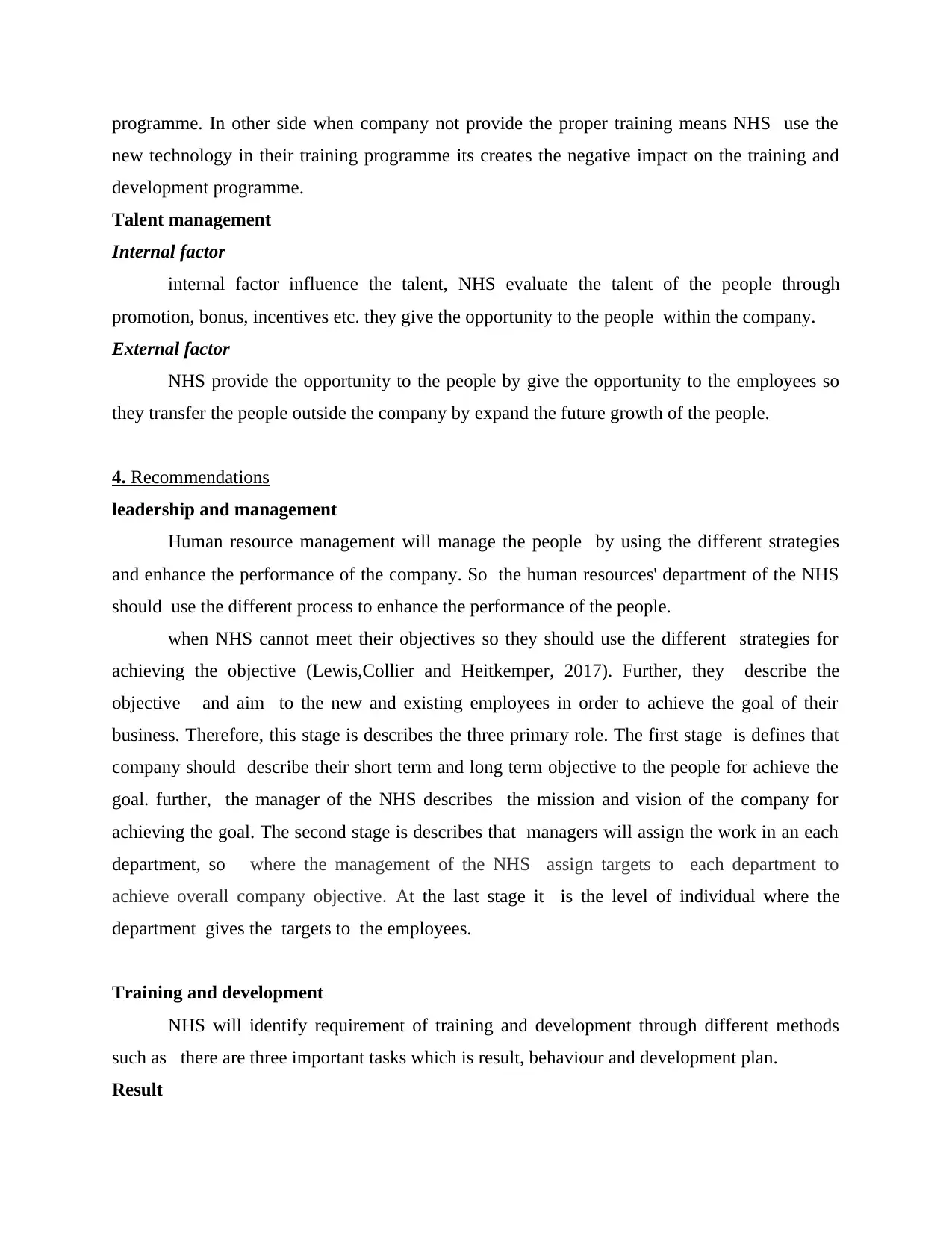
programme. In other side when company not provide the proper training means NHS use the
new technology in their training programme its creates the negative impact on the training and
development programme.
Talent management
Internal factor
internal factor influence the talent, NHS evaluate the talent of the people through
promotion, bonus, incentives etc. they give the opportunity to the people within the company.
External factor
NHS provide the opportunity to the people by give the opportunity to the employees so
they transfer the people outside the company by expand the future growth of the people.
4. Recommendations
leadership and management
Human resource management will manage the people by using the different strategies
and enhance the performance of the company. So the human resources' department of the NHS
should use the different process to enhance the performance of the people.
when NHS cannot meet their objectives so they should use the different strategies for
achieving the objective (Lewis,Collier and Heitkemper, 2017). Further, they describe the
objective and aim to the new and existing employees in order to achieve the goal of their
business. Therefore, this stage is describes the three primary role. The first stage is defines that
company should describe their short term and long term objective to the people for achieve the
goal. further, the manager of the NHS describes the mission and vision of the company for
achieving the goal. The second stage is describes that managers will assign the work in an each
department, so where the management of the NHS assign targets to each department to
achieve overall company objective. At the last stage it is the level of individual where the
department gives the targets to the employees.
Training and development
NHS will identify requirement of training and development through different methods
such as there are three important tasks which is result, behaviour and development plan.
Result
new technology in their training programme its creates the negative impact on the training and
development programme.
Talent management
Internal factor
internal factor influence the talent, NHS evaluate the talent of the people through
promotion, bonus, incentives etc. they give the opportunity to the people within the company.
External factor
NHS provide the opportunity to the people by give the opportunity to the employees so
they transfer the people outside the company by expand the future growth of the people.
4. Recommendations
leadership and management
Human resource management will manage the people by using the different strategies
and enhance the performance of the company. So the human resources' department of the NHS
should use the different process to enhance the performance of the people.
when NHS cannot meet their objectives so they should use the different strategies for
achieving the objective (Lewis,Collier and Heitkemper, 2017). Further, they describe the
objective and aim to the new and existing employees in order to achieve the goal of their
business. Therefore, this stage is describes the three primary role. The first stage is defines that
company should describe their short term and long term objective to the people for achieve the
goal. further, the manager of the NHS describes the mission and vision of the company for
achieving the goal. The second stage is describes that managers will assign the work in an each
department, so where the management of the NHS assign targets to each department to
achieve overall company objective. At the last stage it is the level of individual where the
department gives the targets to the employees.
Training and development
NHS will identify requirement of training and development through different methods
such as there are three important tasks which is result, behaviour and development plan.
Result
Paraphrase This Document
Need a fresh take? Get an instant paraphrase of this document with our AI Paraphraser
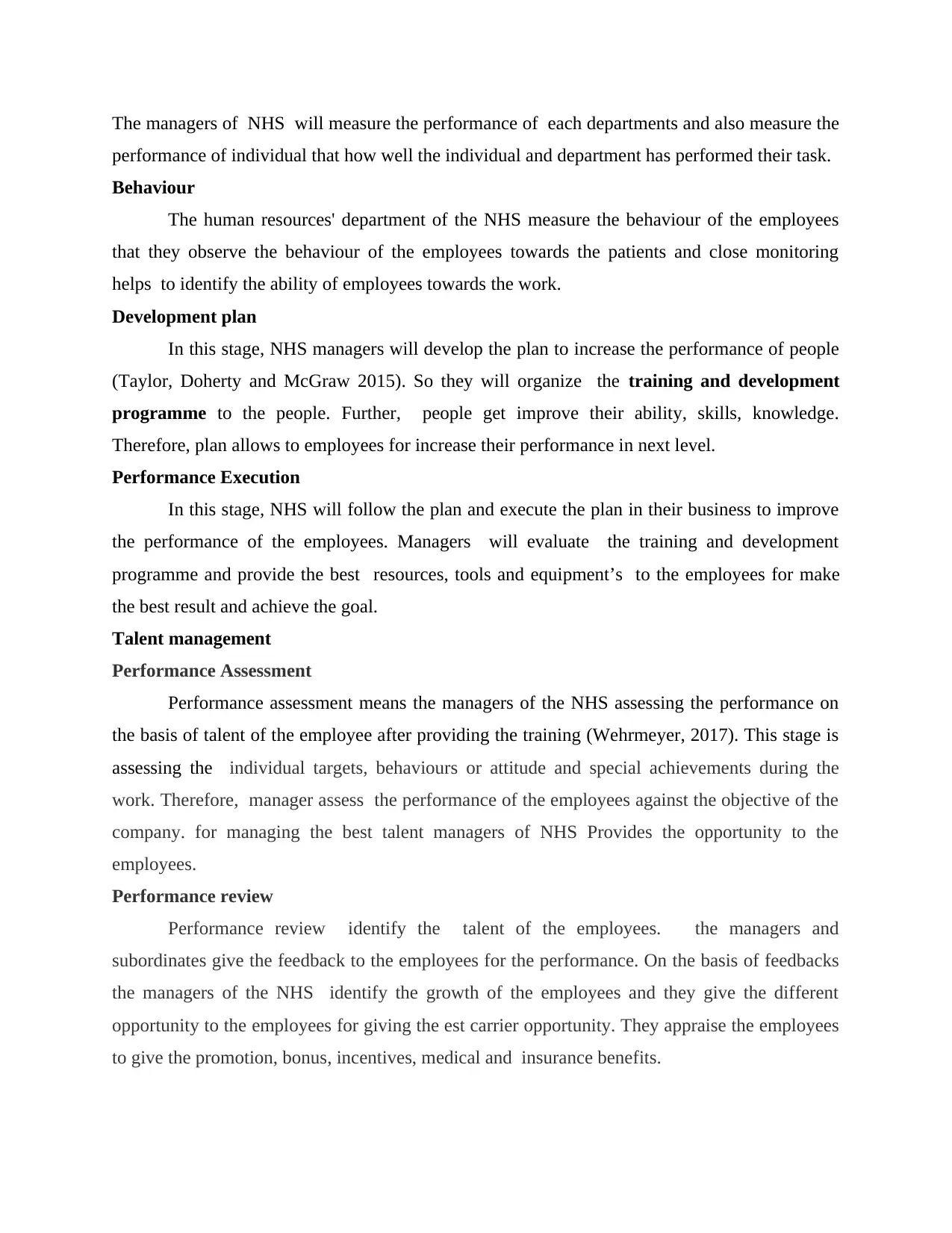
The managers of NHS will measure the performance of each departments and also measure the
performance of individual that how well the individual and department has performed their task.
Behaviour
The human resources' department of the NHS measure the behaviour of the employees
that they observe the behaviour of the employees towards the patients and close monitoring
helps to identify the ability of employees towards the work.
Development plan
In this stage, NHS managers will develop the plan to increase the performance of people
(Taylor, Doherty and McGraw 2015). So they will organize the training and development
programme to the people. Further, people get improve their ability, skills, knowledge.
Therefore, plan allows to employees for increase their performance in next level.
Performance Execution
In this stage, NHS will follow the plan and execute the plan in their business to improve
the performance of the employees. Managers will evaluate the training and development
programme and provide the best resources, tools and equipment’s to the employees for make
the best result and achieve the goal.
Talent management
Performance Assessment
Performance assessment means the managers of the NHS assessing the performance on
the basis of talent of the employee after providing the training (Wehrmeyer, 2017). This stage is
assessing the individual targets, behaviours or attitude and special achievements during the
work. Therefore, manager assess the performance of the employees against the objective of the
company. for managing the best talent managers of NHS Provides the opportunity to the
employees.
Performance review
Performance review identify the talent of the employees. the managers and
subordinates give the feedback to the employees for the performance. On the basis of feedbacks
the managers of the NHS identify the growth of the employees and they give the different
opportunity to the employees for giving the est carrier opportunity. They appraise the employees
to give the promotion, bonus, incentives, medical and insurance benefits.
performance of individual that how well the individual and department has performed their task.
Behaviour
The human resources' department of the NHS measure the behaviour of the employees
that they observe the behaviour of the employees towards the patients and close monitoring
helps to identify the ability of employees towards the work.
Development plan
In this stage, NHS managers will develop the plan to increase the performance of people
(Taylor, Doherty and McGraw 2015). So they will organize the training and development
programme to the people. Further, people get improve their ability, skills, knowledge.
Therefore, plan allows to employees for increase their performance in next level.
Performance Execution
In this stage, NHS will follow the plan and execute the plan in their business to improve
the performance of the employees. Managers will evaluate the training and development
programme and provide the best resources, tools and equipment’s to the employees for make
the best result and achieve the goal.
Talent management
Performance Assessment
Performance assessment means the managers of the NHS assessing the performance on
the basis of talent of the employee after providing the training (Wehrmeyer, 2017). This stage is
assessing the individual targets, behaviours or attitude and special achievements during the
work. Therefore, manager assess the performance of the employees against the objective of the
company. for managing the best talent managers of NHS Provides the opportunity to the
employees.
Performance review
Performance review identify the talent of the employees. the managers and
subordinates give the feedback to the employees for the performance. On the basis of feedbacks
the managers of the NHS identify the growth of the employees and they give the different
opportunity to the employees for giving the est carrier opportunity. They appraise the employees
to give the promotion, bonus, incentives, medical and insurance benefits.
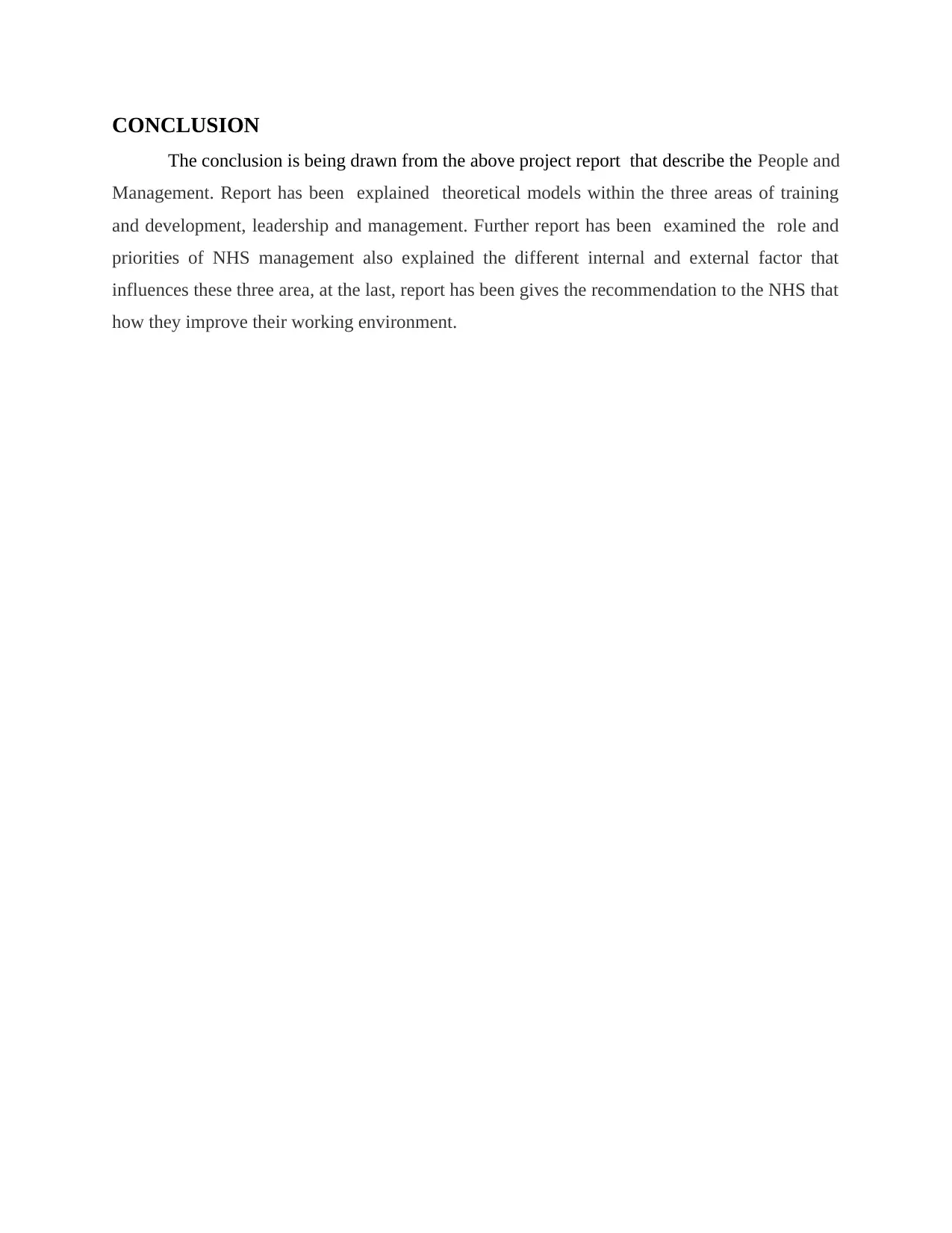
CONCLUSION
The conclusion is being drawn from the above project report that describe the People and
Management. Report has been explained theoretical models within the three areas of training
and development, leadership and management. Further report has been examined the role and
priorities of NHS management also explained the different internal and external factor that
influences these three area, at the last, report has been gives the recommendation to the NHS that
how they improve their working environment.
The conclusion is being drawn from the above project report that describe the People and
Management. Report has been explained theoretical models within the three areas of training
and development, leadership and management. Further report has been examined the role and
priorities of NHS management also explained the different internal and external factor that
influences these three area, at the last, report has been gives the recommendation to the NHS that
how they improve their working environment.
⊘ This is a preview!⊘
Do you want full access?
Subscribe today to unlock all pages.

Trusted by 1+ million students worldwide
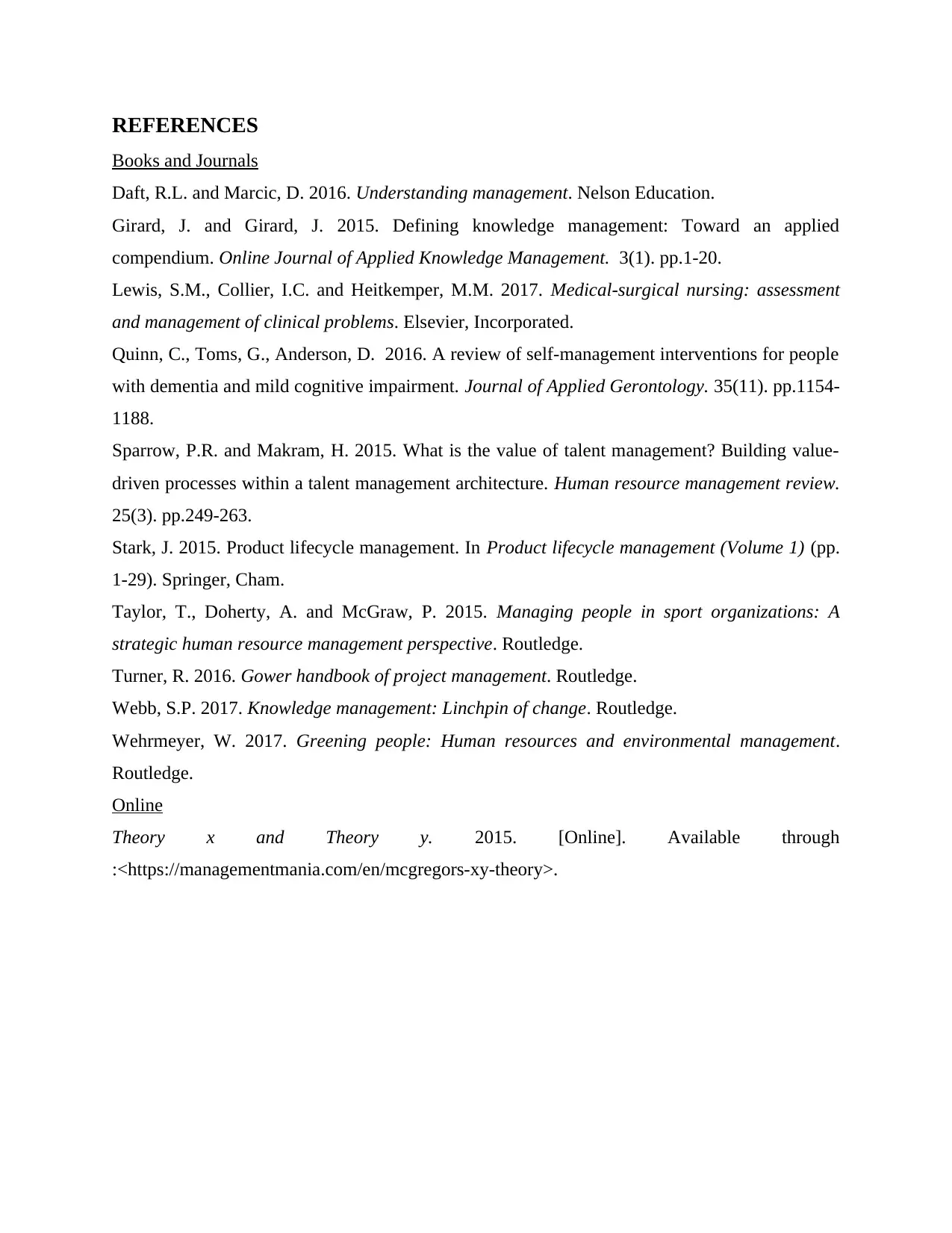
REFERENCES
Books and Journals
Daft, R.L. and Marcic, D. 2016. Understanding management. Nelson Education.
Girard, J. and Girard, J. 2015. Defining knowledge management: Toward an applied
compendium. Online Journal of Applied Knowledge Management. 3(1). pp.1-20.
Lewis, S.M., Collier, I.C. and Heitkemper, M.M. 2017. Medical-surgical nursing: assessment
and management of clinical problems. Elsevier, Incorporated.
Quinn, C., Toms, G., Anderson, D. 2016. A review of self-management interventions for people
with dementia and mild cognitive impairment. Journal of Applied Gerontology. 35(11). pp.1154-
1188.
Sparrow, P.R. and Makram, H. 2015. What is the value of talent management? Building value-
driven processes within a talent management architecture. Human resource management review.
25(3). pp.249-263.
Stark, J. 2015. Product lifecycle management. In Product lifecycle management (Volume 1) (pp.
1-29). Springer, Cham.
Taylor, T., Doherty, A. and McGraw, P. 2015. Managing people in sport organizations: A
strategic human resource management perspective. Routledge.
Turner, R. 2016. Gower handbook of project management. Routledge.
Webb, S.P. 2017. Knowledge management: Linchpin of change. Routledge.
Wehrmeyer, W. 2017. Greening people: Human resources and environmental management.
Routledge.
Online
Theory x and Theory y. 2015. [Online]. Available through
:<https://managementmania.com/en/mcgregors-xy-theory>.
Books and Journals
Daft, R.L. and Marcic, D. 2016. Understanding management. Nelson Education.
Girard, J. and Girard, J. 2015. Defining knowledge management: Toward an applied
compendium. Online Journal of Applied Knowledge Management. 3(1). pp.1-20.
Lewis, S.M., Collier, I.C. and Heitkemper, M.M. 2017. Medical-surgical nursing: assessment
and management of clinical problems. Elsevier, Incorporated.
Quinn, C., Toms, G., Anderson, D. 2016. A review of self-management interventions for people
with dementia and mild cognitive impairment. Journal of Applied Gerontology. 35(11). pp.1154-
1188.
Sparrow, P.R. and Makram, H. 2015. What is the value of talent management? Building value-
driven processes within a talent management architecture. Human resource management review.
25(3). pp.249-263.
Stark, J. 2015. Product lifecycle management. In Product lifecycle management (Volume 1) (pp.
1-29). Springer, Cham.
Taylor, T., Doherty, A. and McGraw, P. 2015. Managing people in sport organizations: A
strategic human resource management perspective. Routledge.
Turner, R. 2016. Gower handbook of project management. Routledge.
Webb, S.P. 2017. Knowledge management: Linchpin of change. Routledge.
Wehrmeyer, W. 2017. Greening people: Human resources and environmental management.
Routledge.
Online
Theory x and Theory y. 2015. [Online]. Available through
:<https://managementmania.com/en/mcgregors-xy-theory>.
1 out of 10
Related Documents
Your All-in-One AI-Powered Toolkit for Academic Success.
+13062052269
info@desklib.com
Available 24*7 on WhatsApp / Email
![[object Object]](/_next/static/media/star-bottom.7253800d.svg)
Unlock your academic potential
Copyright © 2020–2025 A2Z Services. All Rights Reserved. Developed and managed by ZUCOL.





